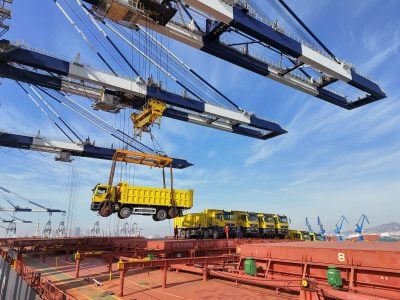The Asian Aspiration examines what Africa can learn from the explosive economic growth of Asian countries over the last half century. Review by Stephen Williams
The issue of why the Asian region has developed so markedly compared to Africa is a question that has gripped development economists for many years.
At independence, in the mid 1960s, African and Asian nations were roughly equivalent in terms of their economic and social trajectories yet, within a few decades, had significantly diverged in so many important measures. Whether it is terms of debt, GDP, poverty rates or levels of infrastructure, Africa has significantly underperformed the Asian region.
The Asian Aspiration, written by former Nigerian and Ethiopian leaders Olusegun Obasanjo and Hailemariam Desalegn alongside Greg Mills and Emily van der Merwe at the Brenthurst Foundation, chronicles the untold stories of explosive growth and changing fortunes: the leaders, events and policy choices that lifted a billion people out of abject poverty within a single generation. It asks what lessons Africa can apply from this historic achievement.
This book attempts to provide an analysis of the recent history of Asia in chapters on Japan, Taiwan, Singapore, South Korea, Philippines, Malaysia, Indonesia, Thailand, China and Vietnam.
The authors discuss the authoritarian tendencies of a number of Asian leaders and whether or not this benefited economic development.
The verdict seems to be “no”, which will come as a surprise to supporters of African autocrats who argue only strongman policies can deliver national unity and economic stability. Rather, the chapters that outline the various Asian nations’ development paths demonstrate that the region is just as politically diverse as Africa with different models historically leading to impressive success and stunning failure. Just how diverse is illustrated by the case of Japan compared to the Philippines. Japan’s remarkable recovery from the ashes of World War II followed the US delivery of $15.2bn between 1945 and the end of its occupation in 1952 along with important reforms encouraging labour unions, land reform and women’s suffrage in the late 1940s.
“Within 10 years of Japan’s shipyards being allowed to produce again in 1952, Japan overtook Britain as the world’s biggest shipbuilders, the Kure yard foremost among them. The vanquished quickly became the victors. Similar stories were repeated in the automotive and motorcycle industries.” At the heart of this business revolution was an enabling policy environment.
“You need to have fierce policy competition, which is focused principally on the benefit to business as the key customer of government,” the authors quote Kenichi Ohno, who has advised the Ethiopian government and others, as saying. “That is why and how Asia works.”
But in the Philippines, where the US also had a significant role in the post World War II scenario, Washington was content to run the archipelago through local power brokers. Central government was ineffective while real political power lay with local potentates – a sure-fire recipe for bad governance.
Large-scale international borrowing was used, not as in Taiwan or Korea to drive industrialisation, but for elite plundering. By the time the dictatorial Ferdinand Marcos period ended due to a 1986 uprising, the country was “mired in debt, with widening poverty and unemployment amid extensive corruption and human rights abuses”.
Following the Marcos era a string of presidents, most of whom faced allegations of corruption after leaving office, supervised a stuttering economy that did little to lift a long-suffering population from poverty.
The contrast between Japan and the Philippines’ post-war fortunes is stark. Examining the reasons for their sharp divergence offers clues as to the different paths that African nations could take – they could forge genuinely open economies with fierce competition, or sink to a battle among local elites for the spoils of governance.
Other national profiles include individual chapters on China’s rapid growth; Vietnam and Cambodia’s extraordinary recovery from the horrific conflicts of the 1970s; the experience of South Korea, Thailand and Singapore; and a history of the massive population booms of Malaysia and Indonesia.
Lessons for Africa
The lessons for Africa that can be drawn from the recent history of Asian nations are considered in the second part of this intriguing book.
As the authors make clear: “Asia can claim no special legacy of good institutions, or a less damaging colonial past. Despite the divergence in their respective development trajectories, over the past 50 years, Southeast Asia and Africa enjoy prominent historical parallels.”
That said, Southeast Asia’s 20th century economic transformation has its origin in the way that systems of government evolved to lift the fortunes of billions of people. Can this trend be replicated in Africa? Here, the book is less clear. It presents a number of theories without pinning its conclusion with any certainty – instead, presenting the idea that Asia is so big and diverse “it is difficult to generalise about common values”.
This smacks of something of a compromise – rather than reaching a conclusion the authors choose to present a number of hypotheses and ask the reader to select one or more that might explain just why Asia and Africa have such different development experiences. Nevertheless, by drawing together the thoughts of so many experts this book is a valuable contribution to a debate on just how Africa should move forward and make the most of the opportunities it possesses.
But a couple of paragraphs leap out as especially pertinent. “Most economies develop in stages. While development is not a destination, there were signposts along the way [in the case of Asia] that included agricultural reform, frequently catalysed in the case of East Asia by large-scale investment in agriculture. Land redistribution was premised on increased productivity, alongside (or followed by) universal access to education.
“This was often followed, in the case of Japan, Taiwan, Korea and China, by urban growth and the rise of light manufacturing, spurred by agro-processing.”
The relevance of Asia’s example comes as Africa is facing a population boom, which can either lead to crisis or prosperity; and as Asia is again transforming, this time out of low-cost manufacturing into high-tech, leaving a void that is Africa’s for the taking – if it can learn the right lessons from the Asian experience.
In the words of Ellen Johnson Sirleaf, former president of Liberia: “Asia’s rapid progress reveals there is no enduring reason why Africa should be poor.”
Related article
Want to continue reading? Subscribe today.
You've read all your free articles for this month! Subscribe now to enjoy full access to our content.
Digital Monthly
£8.00 / month
Receive full unlimited access to our articles, opinions, podcasts and more.
Digital Yearly
£70.00 / year
Our best value offer - save £26 and gain access to all of our digital content for an entire year!
 Sign in with Google
Sign in with Google 


